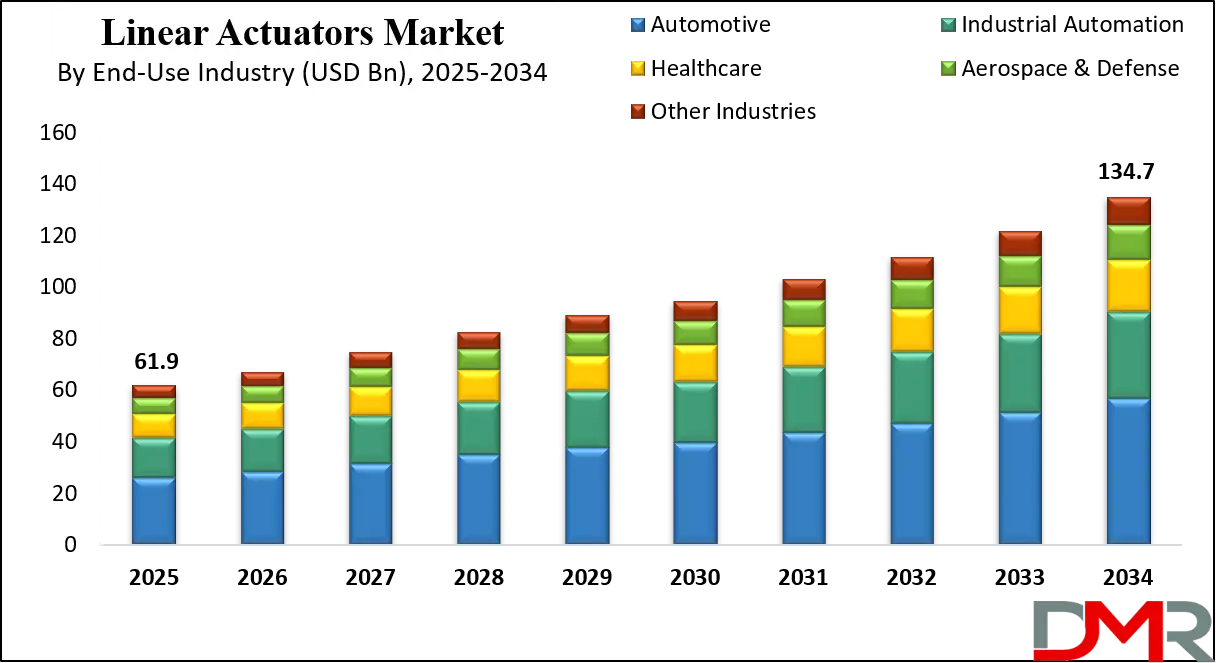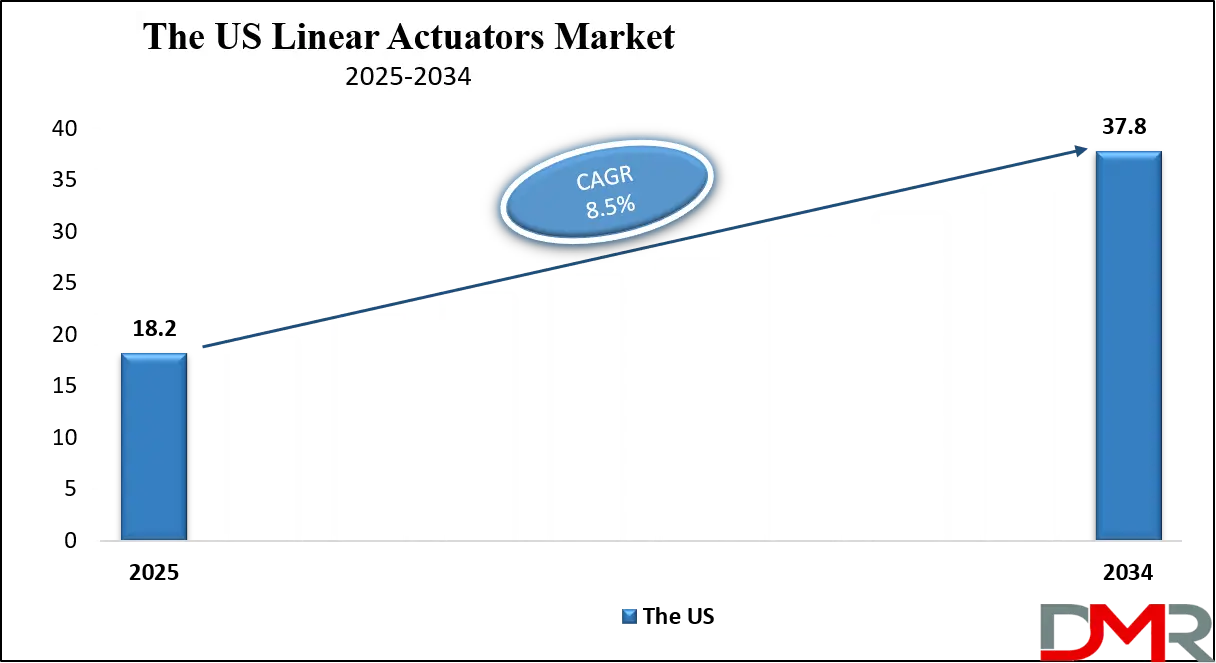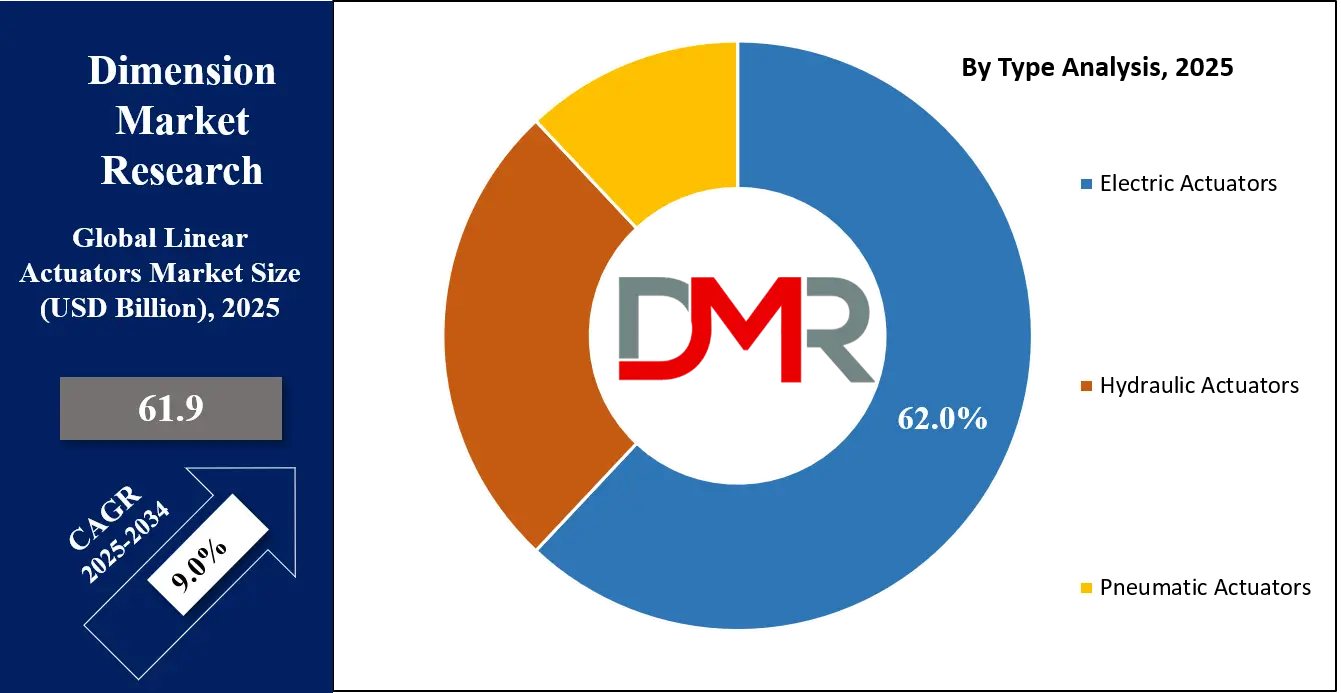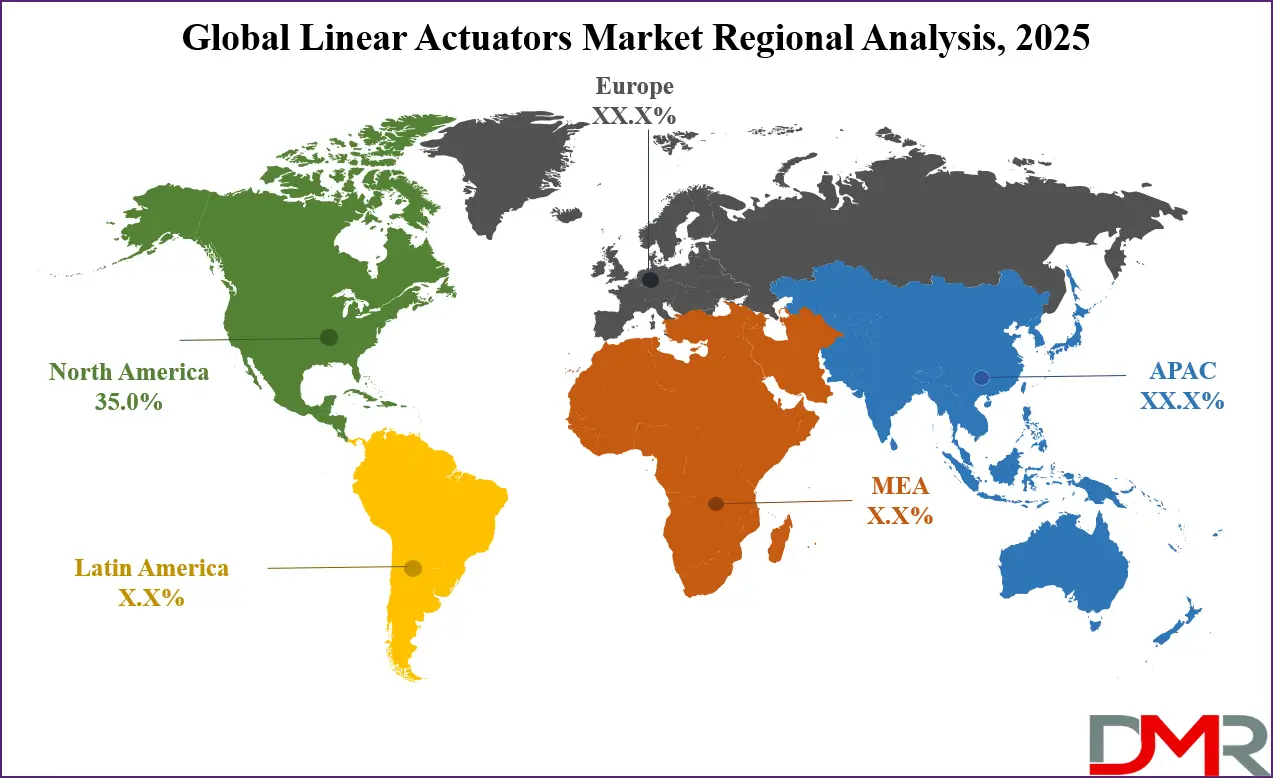Market Overview
The global linear actuators market is projected at USD 61.9 billion in 2025 and is expected to reach USD 134.7 billion by 2034, growing at a CAGR of 9.0%.
Rising adoption of industrial automation, robotics, automotive applications, and healthcare equipment, along with advancements in electric, hydraulic, and pneumatic actuator technologies, is driving market expansion. Increasing demand for precision motion control and smart actuator systems is further fueling growth across North America, Europe, and Asia-Pacific, while emerging economies present new opportunities for industrial and infrastructure applications.

A linear actuator is a mechanical device that converts rotational or electrical energy into straight-line motion, enabling precise positioning and controlled movement of machinery and equipment. These actuators are essential components in a variety of applications ranging from industrial automation to healthcare, automotive, and aerospace systems. By controlling motion along a single axis, linear actuators improve operational efficiency, enhance accuracy, and provide reliable performance in tasks that require lifting, pushing, pulling, or adjusting components.
They can be powered by electric, hydraulic, or pneumatic systems, and are often integrated with sensors and controllers to enable automated or remote operation. The adaptability of linear actuators allows them to meet the growing demands of modern technology-driven industries.
The global linear actuators market is experiencing significant growth due to the growing adoption of automation across industrial sectors and the rising demand for advanced machinery in automotive and healthcare applications. The market encompasses various types of actuators including electric, hydraulic, and pneumatic systems, each serving diverse end-use industries such as industrial automation, robotics, aerospace, and energy.
Technological advancements, including smart actuator systems and IoT-enabled devices, are driving innovation and expanding the scope of applications for linear actuators. Increasing investments in research and development and a focus on energy-efficient solutions further contribute to the expansion of the market.
Regionally, the linear actuators market is witnessing rapid adoption in Asia-Pacific driven by industrialization, manufacturing growth, and the rising deployment of automation technologies. North America and Europe remain key markets with established industrial bases and a strong focus on smart manufacturing and precision engineering. The integration of linear actuators in medical equipment, robotics, and automotive technologies continues to fuel demand globally.

Emerging economies are also investing in infrastructure development and industrial automation, creating new opportunities for market growth and innovation. Market players are focusing on product differentiation, enhanced performance, and customization to meet specific industry requirements, shaping the competitive landscape and driving the overall expansion of the global linear actuators market.
The US Linear Actuators Market
The U.S. Linear Actuators market size is projected to be valued at USD 61.9 billion by 2025. It is further expected to witness subsequent growth in the upcoming period, holding USD 37.8 billion in 2034 at a CAGR of 8.5%.
The U.S. linear actuators market is witnessing robust growth, driven by increasing demand for automation, precision motion control, and advanced manufacturing technologies across various industries. Linear actuators, which convert energy into controlled linear movement, are widely used in industrial automation, robotics, aerospace, automotive systems, and healthcare equipment in the country.
Electric actuators dominate the U.S. market due to their energy efficiency, adaptability, and compatibility with smart manufacturing systems, while hydraulic and pneumatic actuators are preferred for heavy-duty and high-speed applications. The adoption of IoT-enabled devices and smart actuator systems is enhancing operational efficiency, enabling remote monitoring, and improving reliability for U.S.-based industries.
North America’s strong industrial base, advanced manufacturing capabilities, and emphasis on Industry 4.0 standards continue to drive the growth of linear actuators in the U.S. Automotive and robotics applications significantly contribute to market demand, while healthcare and medical equipment sectors are increasingly incorporating electric actuators for ergonomic and automated solutions. Continuous investments in research and development, focus on energy-efficient and compact actuator designs, and a competitive landscape emphasizing product innovation and customization are further shaping the U.S. linear actuators market, ensuring steady expansion over the coming years.

Europe Linear Actuators Market
The European linear actuators market is projected to reach approximately USD 12.9 billion in 2025, reflecting its significance as one of the key regional markets globally. This substantial market size is driven by Europe’s well-established industrial base, advanced manufacturing sector, and strong adoption of automation technologies.
Industries such as automotive, aerospace, healthcare, and industrial machinery heavily rely on linear actuators for precise motion control, efficient production processes, and enhanced operational reliability. Electric actuators dominate the region due to their energy efficiency, ease of integration with smart manufacturing systems, and compatibility with IoT-enabled devices, while hydraulic and pneumatic actuators continue to serve heavy-duty applications.
The market is expected to grow at a moderate CAGR of 5.4% during the forecast period, indicating steady and sustainable expansion. This growth is supported by continuous investment in research and development of advanced actuator technologies, such as compact, energy-efficient, and smart linear actuators.The rising trend of Industry 4.0 adoption, automation in production lines, and implementation of predictive maintenance systems further enhances demand.
Additionally, European manufacturers are focusing on product innovation, customization, and integration with AI and IoT systems to meet evolving industrial requirements, ensuring the region maintains a strong position in the global linear actuators market.
Japan Linear Actuators Market
The Japanese linear actuators market is projected to reach approximately USD 3.1 billion in 2025, reflecting its growing importance in the global actuator industry. This market size is driven by Japan’s leadership in precision engineering, robotics, and advanced manufacturing technologies. Linear actuators are widely used across automotive, industrial automation, healthcare, and aerospace sectors, where they provide precise motion control, reliability, and efficiency. Electric actuators are particularly favored due to their compact design, energy efficiency, and seamless integration with smart systems, while hydraulic and pneumatic actuators continue to serve applications requiring high force and heavy-duty operations.
The market in Japan is expected to grow at a robust CAGR of 9.6%, indicating strong expansion over the forecast period. This rapid growth is fueled by growing adoption of automation and smart manufacturing technologies, rising investments in robotics, and the growing demand for energy-efficient and compact actuator solutions. Japanese companies are also focusing on innovations in IoT-enabled and AI-integrated actuators to enhance operational performance and predictive maintenance capabilities. The combination of technological advancements, industrial modernization, and a focus on precision-driven applications ensures that Japan will remain a key growth market for linear actuators globally.
Global Linear Actuators Market: Key Takeaways
- Market Value: The global Linear Actuators market size is expected to reach a value of USD 134.7 billion by 2034 from a base value of USD 61.9 billion in 2025 at a CAGR of 9.0%.
- By Type Segment Analysis: Electric Actuators will dominate the type segment, capturing 62.0% of the market share in 2025.
- By End-Use Industry Segment Analysis: The Automotive industry will account for the maximum share in the end-use industry segment, capturing 42.0% of the total market value.
- Regional Analysis: North America is anticipated to lead the global Linear Actuators market landscape with 35.0% of total global market revenue in 2025.
- Key Players: Some key players in the global Linear Actuators market are SMC Corporation, Parker Hannifin Corporation, Emerson Electric Co., ABB Ltd., Rockwell Automation, Thomson Industries, Bimba Manufacturing, Festo AG & Co. KG, Bosch Rexroth AG, Del-Tron Precision Inc., LINAK A/S, Tolomatic Inc., Progressive Automations, and Others.
Global Linear Actuators Market: Use Cases
- Industrial Automation and Robotics: Linear actuators play a critical role in industrial automation by enabling precise motion control for robotic arms, conveyor systems, and assembly lines. They allow manufacturers to automate repetitive tasks, increase production efficiency, and reduce human error. Electric actuators are commonly integrated with sensors and programmable controllers to achieve accurate positioning, while pneumatic and hydraulic actuators handle high-force operations. The growing adoption of smart factories and Industry 4.0 technologies is driving demand for advanced linear actuators that support automation and real-time process optimization.
- Automotive Applications: In the automotive sector, linear actuators are used in vehicle systems such as adjustable seats, power windows, convertible roof mechanisms, and mirror positioning. Electric actuators are preferred due to their compact design, reliability, and energy efficiency. The rising demand for electric vehicles (EVs) and advanced driver-assistance systems (ADAS) has further boosted the need for precise, durable actuators. Automakers are increasingly integrating actuators for automated functions, improving passenger comfort, safety, and vehicle performance.
- Healthcare and Medical Equipment: Linear actuators are essential components in healthcare devices, including hospital beds, patient lifts, surgical tables, and diagnostic imaging equipment. Actuators provide smooth, reliable, and controlled motion, enabling better patient care and operational efficiency. Electric and compact actuators are favored for medical applications due to their quiet operation and precise positioning capabilities. The growing adoption of automation in healthcare facilities, along with the need for ergonomic and safe equipment, is fueling market growth in this segment.
- Aerospace and Defense Systems: In aerospace and defense, linear actuators are used for controlling aircraft landing gear, flight control surfaces, missile systems, and satellite positioning mechanisms. Hydraulic and electric actuators offer high force, precision, and reliability in extreme environments. The demand for unmanned aerial vehicles (UAVs), advanced defense systems, and commercial aircraft automation is driving the adoption of robust and lightweight actuators. Manufacturers focus on actuator innovations that improve durability, reduce maintenance, and support mission-critical operations in challenging conditions.
Impact of Artificial Intelligence on Linear Actuators Market
Artificial intelligence is transforming the linear actuators market by enabling smarter, more autonomous motion control systems across industries. AI-powered actuators can analyze real-time operational data, predict maintenance needs, and optimize performance for industrial automation, robotics, and healthcare equipment. Integration with machine learning algorithms allows actuators to adapt to varying loads and environmental conditions, enhancing precision, efficiency, and reliability.
In automotive and aerospace applications, AI facilitates predictive diagnostics and autonomous adjustments, reducing downtime and improving safety. The convergence of AI and IoT technologies is driving innovation, creating intelligent actuator solutions that meet the growing demand for automation and smart systems globally.
Global Linear Actuators Market: Market Dynamics
Global Linear Actuators Market: Driving Factors
Rising Adoption of Industrial Automation
The growing focus on industrial automation is a primary driver for the linear actuators market. Industries such as manufacturing, automotive, and electronics are integrating robotic systems and automated machinery, where linear actuators provide precise motion control and efficient positioning. The demand for reducing manual intervention, improving production efficiency, and implementing Industry 4.0 standards is accelerating the adoption of electric, hydraulic, and pneumatic actuators, thereby driving market growth globally.
Growing Demand in Healthcare and Medical Equipment
Linear actuators are increasingly used in healthcare devices, including hospital beds, surgical tables, diagnostic imaging systems, and patient lifts. The rising need for ergonomic, automated, and patient-friendly equipment is boosting actuator adoption. Technological advancements, compact designs, and quiet operation features of modern actuators are encouraging healthcare providers to replace manual systems with automated solutions, supporting growth in the global market.
Global Linear Actuators Market: Restraints
High Initial Investment and Cost Concerns
Despite their efficiency, linear actuators often involve significant upfront costs, especially electric and hydraulic models with advanced control systems. Small and medium-sized enterprises may find adoption financially challenging, limiting penetration in certain industries. High installation and maintenance expenses can restrain widespread deployment, especially in cost-sensitive emerging markets.
Technical Limitations in Extreme Environments
Linear actuators can face operational challenges in harsh environments involving extreme temperatures, high humidity, or corrosive conditions. Pneumatic and hydraulic actuators may experience leakage or wear, while electric actuators may face performance degradation. These technical constraints limit the suitability of actuators in some industrial or outdoor applications, restricting market expansion.
Global Linear Actuators Market: Opportunities
Integration with IoT and Smart Systems
The integration of linear actuators with IoT-enabled devices and smart manufacturing systems presents significant growth opportunities. Real-time monitoring, predictive maintenance, and remote control capabilities allow industries to optimize operations, reduce downtime, and improve energy efficiency. Smart actuators with AI-driven analytics are gaining traction in robotics, aerospace, and smart infrastructure applications.
Expansion in Emerging Economies
Emerging economies in Asia-Pacific, Latin America, and the Middle East are increasingly investing in industrial automation, healthcare infrastructure, and smart manufacturing. The growing industrial base, rising infrastructure projects, and government initiatives to adopt automation present new market opportunities for actuator manufacturers. Cost-effective solutions targeting these regions can further expand market reach.
Global Linear Actuators Market: Trends
Shift towards Electric and Compact Actuators
There is a noticeable trend towards electric actuators due to their energy efficiency, precise positioning, and ease of integration into automated systems. Compact and lightweight designs are preferred for robotics, medical devices, and automotive applications, enabling better space utilization and improved system performance.
Adoption of Predictive Maintenance and Smart Control Systems
Linear actuators are increasingly being combined with sensors and smart controllers for predictive maintenance. By analyzing operational data, these systems can forecast wear and optimize performance, reducing downtime and extending equipment life. This trend is particularly prominent in industrial automation, aerospace, and healthcare sectors, driving demand for advanced actuator solutions.
Global Linear Actuators Market: Research Scope and Analysis
By Type Analysis
In the global linear actuators market, electric actuators are expected to dominate the type segment, capturing around 62.0% of the market share in 2025. This dominance is attributed to their high energy efficiency, precision control, and versatility across various industrial, automotive, and healthcare applications. Electric actuators are preferred in automated systems because they can be easily integrated with sensors and controllers, allowing for accurate positioning, smooth motion, and remote operation. Their ability to provide consistent performance with low maintenance requirements makes them the most widely adopted choice in modern manufacturing and robotics.
Hydraulic actuators, on the other hand, hold a significant portion of the type segment due to their high force output and capability to handle heavy-duty applications. They are commonly used in industrial machinery, construction equipment, and aerospace systems where substantial load-bearing capacity and robust performance are required. Although hydraulic actuators are less energy-efficient compared to electric models, their reliability in harsh and high-pressure environments ensures steady demand in sectors that require powerful and durable motion solutions.

By End-Use Industry Analysis
In the global linear actuators market, the automotive industry is expected to account for the largest share in the end-use industry segment, capturing approximately 42.0% of the total market value. This substantial share is driven by the growing adoption of electric vehicles and advanced driver-assistance systems, which require precise and reliable actuator solutions for functions such as adjustable seats, power windows, convertible roofs, and mirror positioning.
The growing emphasis on vehicle automation, safety features, and passenger comfort is further boosting the demand for electric and compact linear actuators in the automotive sector. Manufacturers are also focusing on integrating actuators into lightweight and energy-efficient designs to meet evolving industry standards and consumer expectations.
The industrial automation segment holds a significant portion of the end-use market due to the widespread implementation of automated machinery, robotic arms, and conveyor systems across manufacturing and production facilities. Linear actuators in this segment are crucial for enabling precise motion control, reducing human intervention, and enhancing operational efficiency.
Electric actuators are widely preferred for tasks requiring accuracy and repeatability, while hydraulic and pneumatic actuators are used in heavy-duty applications where high force is necessary. The ongoing adoption of smart factories, Industry 4.0 technologies, and automated production processes continues to drive growth and expand the utilization of actuators in industrial automation.
The Linear Actuators Market Report is segmented on the basis of the following:
By Type
- Electric Actuators
- AC Electric
- DC Electric
- Stepper Electric
- Hydraulic Actuators
- Single-acting
- Double-acting
- Pneumatic Actuators
By End-Use Industry
- Automotive
- Passenger Vehicles
- Commercial Vehicles
- Industrial Automation
- Robotics
- Conveyor Systems
- Material Handling
- Healthcare
- Hospital Equipment
- Diagnostic Devices
- Aerospace & Defense
- Aircraft Systems
- Defense Equipment
- Other Industries
- Agriculture
- Construction & Energy
Global Linear Actuators Market: Regional Analysis
Region with the Largest Revenue Share
North America is expected to hold the largest revenue share in the global linear actuators market, driven primarily by the United States, which has a well-established industrial base and advanced manufacturing infrastructure. The region benefits from widespread adoption of automation, robotics, and smart manufacturing technologies across automotive, aerospace, and healthcare sectors. Strong demand for precision motion control, integrated with continuous investments in research and development of energy-efficient and compact actuator solutions, supports market growth.
Additionally, North America's emphasis on Industry 4.0 implementation, predictive maintenance systems, and integration of IoT-enabled actuators further reinforces its position as the leading revenue-generating region in the global market.

Region with significant growth
The Asia-Pacific region is expected to witness significant growth in the global linear actuators market, driven by rapid industrialization, expanding manufacturing sectors, and growing adoption of automation technologies in countries such as China, Japan, and India. Rising investments in smart factories, robotics, and infrastructure development are fueling demand for electric, hydraulic, and pneumatic actuators across automotive, healthcare, and industrial applications.
Additionally, the growing focus on cost-effective, energy-efficient solutions and government initiatives to promote advanced manufacturing are creating new opportunities, making Asia-Pacific one of the fastest-growing and most promising regions for linear actuator market expansion.
By Region
North America
Europe
- Germany
- The U.K.
- France
- Italy
- Russia
- Spain
- Benelux
- Nordic
- Rest of Europe
Asia-Pacific
- China
- Japan
- South Korea
- India
- ANZ
- ASEAN
- Rest of Asia-Pacific
Latin America
- Brazil
- Mexico
- Argentina
- Colombia
- Rest of Latin America
Middle East & Africa
- Saudi Arabia
- UAE
- South Africa
- Israel
- Egypt
- Rest of MEA
Global Linear Actuators Market: Competitive Landscape
The global linear actuators market is characterized by a competitive landscape featuring several prominent players that drive innovation and cater to diverse industry needs. Key companies include Rockwell Automation, Parker Hannifin Corporation, Emerson Electric Co., SMC Corporation, and ABB Ltd., each offering a range of actuator solutions across electric, hydraulic, and pneumatic types. Emerging players such as Actuonix Motion Devices, TiMOTION Technology Co., Ltd., and Progressive Automations are gaining traction by providing specialized and cost-effective solutions tailored to specific applications.
The market is further diversified by regional manufacturers and specialized providers like Ewellix and ISOTECH, Inc., which contribute to the dynamic and fragmented nature of the industry. These companies compete on factors such as product innovation, customization capabilities, and integration with smart technologies to meet the evolving demands of sectors like automotive, healthcare, industrial automation, and aerospace.
Some of the prominent players in the global linear actuators market are:
- SMC Corporation
- Parker Hannifin Corporation
- Emerson Electric Co.
- ABB Ltd.
- Rockwell Automation
- Thomson Industries
- Bimba Manufacturing
- Festo AG & Co. KG
- Bosch Rexroth AG
- Del-Tron Precision Inc.
- LINAK A/S
- Tolomatic Inc.
- Progressive Automations
- Firgelli Automations
- Actuonix Motion Devices
- Venture Mfg. Co.
- Ultra Motion
- IAI America, Inc.
- ElectroCraft Inc.
- Isotech Inc.
- Other Key Players
Global Linear Actuators Market: Recent Developments
- June 2025: Power Jacks introduced the POWERAM electric linear actuator range, designed to facilitate the automation of manual systems and transition from hydraulic to electro-mechanical linear motion.
- April 2025: igus launched the SLX-8060 linear actuator with a lead screw drive, expanding their portfolio to offer greater flexibility for customized machine designs.
- September 2024: Nidec Corporation announced the acquisition of Linear Transfer Automation Inc., Linear Automation USA Inc., and Presstrader Limited, enhancing its capabilities in linear automation solutions.
- September 2024: Forest Hill Partners LLC completed the sale of Micromatic LLC, a manufacturer and distributor of actuators and automation solutions, to MITAR Private Capital.
Report Details
| Report Characteristics |
| Market Size (2025) |
USD 61.9 Bn |
| Forecast Value (2034) |
USD 134.7 Bn |
| CAGR (2025–2034) |
9.0% |
| The US Market Size (2025) |
USD 18.2 Bn |
| Historical Data |
2019 – 2024 |
| Forecast Data |
2026 – 2034 |
| Base Year |
2024 |
| Estimate Year |
2025 |
| Report Coverage |
Market Revenue Estimation, Market Dynamics, Competitive Landscape, Growth Factors, etc. |
| Segments Covered |
By Type (Electric Actuators, Hydraulic Actuators, and Pneumatic Actuators), and By End-Use Industry (Automotive, Industrial Automation, Healthcare, Aerospace & Defense, and Other Industries) |
| Regional Coverage |
North America – US, Canada; Europe – Germany, UK, France, Russia, Spain, Italy, Benelux, Nordic, Rest of Europe; Asia-Pacific – China, Japan, South Korea, India, ANZ, ASEAN, Rest of APAC; Latin America – Brazil, Mexico, Argentina, Colombia, Rest of Latin America; Middle East & Africa – Saudi Arabia, UAE, South Africa, Turkey, Egypt, Israel, Rest of MEA |
| Prominent Players |
SMC Corporation, Parker Hannifin Corporation, Emerson Electric Co., ABB Ltd., Rockwell Automation, Thomson Industries, Bimba Manufacturing, Festo AG & Co. KG, Bosch Rexroth AG, Del-Tron Precision Inc., LINAK A/S, Tolomatic Inc., Progressive Automations, and Others. |
| Purchase Options |
We have three licenses to opt for: Single User License (Limited to 1 user), Multi-User License (Up to 5 Users), and Corporate Use License (Unlimited User) along with free report customization equivalent to 0 analyst working days, 3 analysts working days, and 5 analysts working days respectively. |
Frequently Asked Questions
The global Linear Actuators market size is estimated to have a value of USD 61.9 billion in 2025 and is expected to reach USD 134.7 billion by the end of 2034.
The US Linear Actuators market is projected to be valued at USD 18.2 billion in 2025. It is expected to witness subsequent growth in the upcoming period as it holds USD 37.8 billion in 2034 at a CAGR of 8.5%.
North America is expected to have the largest market share in the global Linear Actuators market, with a share of about 35.0% in 2025.
Some of the major key players in the global Linear Actuators market are SMC Corporation, Parker Hannifin Corporation, Emerson Electric Co., ABB Ltd., Rockwell Automation, Thomson Industries, Bimba Manufacturing, Festo AG & Co. KG, Bosch Rexroth AG, Del-Tron Precision Inc., LINAK A/S, Tolomatic Inc., Progressive Automations, and Others.
The market is growing at a CAGR of 9.0 percent over the forecasted period.